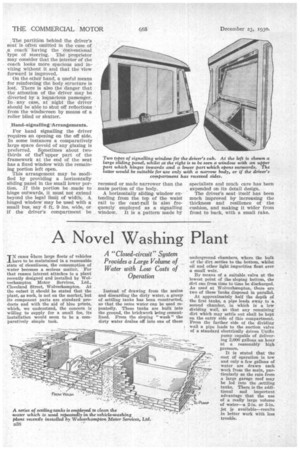A Novel Washing Plant
Page 52

If you've noticed an error in this article please click here to report it so we can fix it.
IN cases Athere large fleets of vehicles have to be maintained in a reasonable state of cleanliness, the consumption of -water becomes a serious matter. For that reason interest attaches to a plant recently designed and installed by Wolverhampton Motor Services, Ltd., Cleveland Street, Wolverhampton. At the outset it should be stated that the plant, as such, is not an the market, but Its component parts are standard products and with the aid of blue prints, which, we understand, the concern is willing to supply for a small fee, its installation would seem to be a comparatively simple task.
Instead of drawing from the mains and discarding the dirty water, a group of settling tanks has been constructed, so that the same water can be used repeatedly. These tanks are built into the ground, the brickwork being cementlined. From the sloping " wash" the dirty water drains off into one of these
underground chambers, where the bulk of the dirt settles to the bottom, whilst oil and other light impurities boat over small weir.
By means of a suitable valve at the lowest point of the sloping bottom, the dirt can from time to time be discharged. As used at Wolverhampton, there are two of these tanks disposed in parallel.
At approximately half the depth of the first tanks, a pipe leads away to a second chamber, in which 1s a low dividing wall, so that any remaining dirt which may settle out shall be kept On the entry side of this compartment. From the farther side of the dividing wall a pipe leads to the suction valve • of a standard electrically driven Unitio pump capable of delivering 2,000 gallons an hour at a reasonably high pressure.
It is stated that the cost of operation is low and only a few gallons of water are drawn each week from the main, particularly as the rain from a large garage roof may be led into the .settling tanks. There is the additional and important advantage that the use of a really large volume of water—a 2-in. or 3-in. jet is available—results in better work with less trouble.




























































































